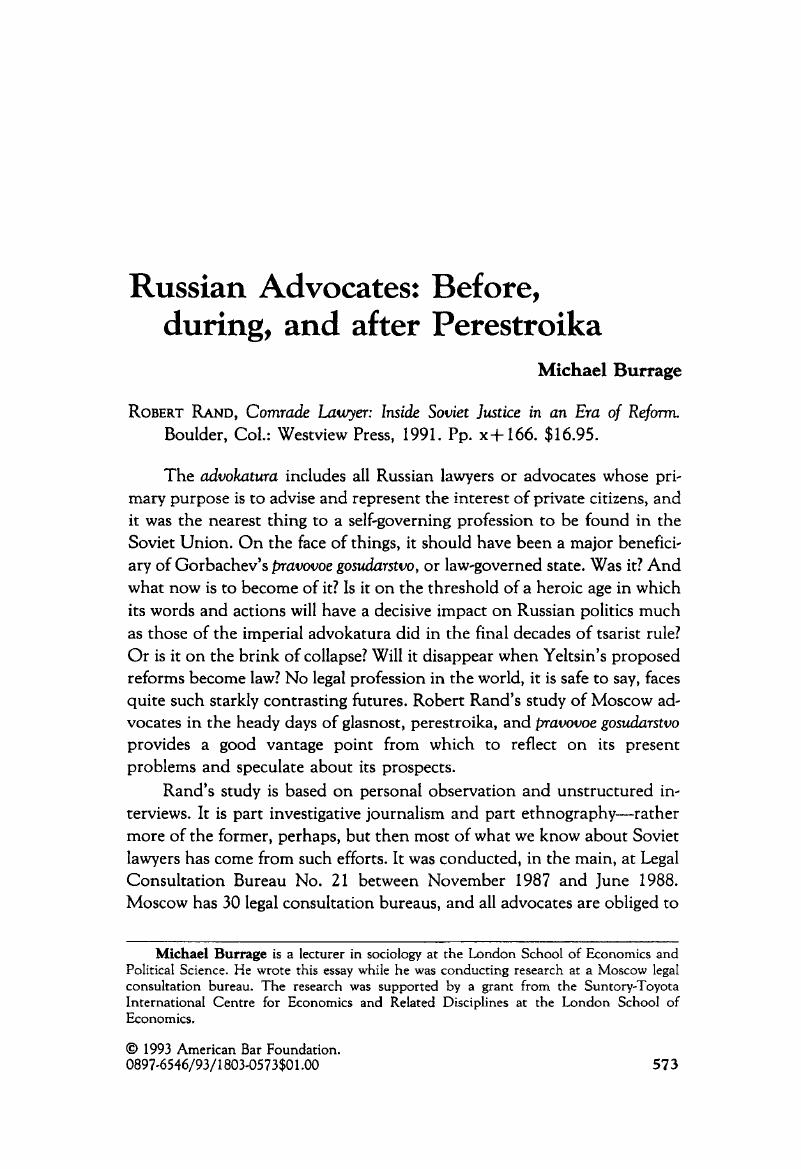Published online by Cambridge University Press: 27 December 2018

1 “He thus supplements the account given in Eugene Huskey, Between Citizen and State: The Soviet Bar (Advokatura) under Gorbachev,” 28 Colum. J. Trunsnat'l L. 1 (1990).Google Scholar
2 For some supporting evidence from about the time when Rand was conducting his research, see Burrage, Michael, “Advokatura: In Search of Professionalism and Pluralism in Moscow and Leningrad,” 15 Law & Soc. Inquiry 433 (1990).CrossRefGoogle Scholar
3 Judah Zelitch, Soviet Administration of Criminal Law (Philadelphia: University of Pennsylvania Press, 1931).CrossRefGoogle Scholar
4 George Feifer, Justice in Moscw (New York: Simon & Schuster, 1964).Google Scholar
5 Marshall MacDuffie, The Red Carpet: 10,000 Miles through Russia on a Visa from Khruschev 39, 53–61 (New York: W. W. Norton, 1955) (“MacDuffie, Red Carpet”).Google Scholar
6 Harold Laski is the only foreign observer who had a kind word for the lay assessors. After his visit to Russia in 1933, he reported “keen competition for the nominations” as lay assessor and that it was “an impressive sight” to watch them in Court. Harold Laski, Law and Justice in Soviet Russia 18–24 (London: Hogarth, 1935); M. S. Calcott, Russian Justice 74, 157–58 (New York: Macmillan, 1935). MacDuffie, Red Carpet 47–52, reports a case in which, in the absence of the judge, three assessors conducted the trial, although they were led through the proceedings by the procurator.Google Scholar
7 See also Paul B. Stephan III, “Comrades' Courts and Labor Discipline since Brezhnev,” in Olimpiad S. Joffe & Mark W. Janis, eds., Soviet Law and Economy 213–32 (The Hague: Martinus Nijhoff, 1987).Google Scholar
8 The Legal Defense Institute evidence on acquittals mentioned above shows that this trial was not wholly atypical, as do my own interviews in 1989. Burrage, 15 Law & Soc. Inquiry at 469–70.Google Scholar
9 For further details, see Isvestiia, 8 Dec. 1990, at 2.Google Scholar
10 For a more detailed account of controls on admission to the advokatura see Bur-rage, 15 Law & Soc. Inquiry at 443–56.Google Scholar
11 On 8 August 1992, Georgii Alekseevich Voskresenkii, now president of the International Union, claimed to me that the two unions had about 40% of their potential membership and the Association about 30%.Google Scholar
12 Marshall S. Shatz, Soviet Dissent in Historical Perspective 138–56 (Cambridge: Cambridge University Press, 1980).Google Scholar
13 Dina Kaminskaya, Final Judgement: My Life as a Soviet Defenre Lawyer 312–17, trans. Michael GIenny (London: Harvill, 1983).Google Scholar
14 C. W. Brooks, Pettifoggers and Vipers of the Commonwealth: The Lower Branch of the Legal Profession in Early Modern England 51–54 (Cambridge: Cambridge University Press, 1986).CrossRefGoogle Scholar
15 For illustrations see Richard B. Morris, “The Legal Profession in America on the Eve of the Revolution,” in Harry W. Jones, ed., Political Separation and Legal Continuity: Papers Prepared for the Bicentennial Observance of the American Bar Association 3–34 (Chicago: American Bar Association, 1976).Google Scholar
16 For documentation see Jules Fabre, Le Barreau de Paris (Paris: Delamotte, 1985); for a perceptive commentary see Lucien Karpik, “Lawyers and Politics in France, 1814–1950: The State, the Market, and the Public,” 13 Law & Soc. Inquiry 707 (1988).Google Scholar
17 Kathryn Hendley, “The Ideals of the Pravovoe Gosudarstvo and the Soviet Workplace: A Case Study of Layoffs,” in Donald D. Barry, ed., Toward the Rule of Law in the Soviet Union? (Armonk, N.Y.: Sharpe, 1992). A survey in the fall of 1992 of a representative sample of 1,844 Moscow residents found that 31.7% had confidence that they could defend their rights in court and 68.3% did not. Kai-Alexander Schlevogt, Private Client Insurance Business in Moscow (Moscow: Colonia Insurance, 1992).Google Scholar
18 Gordon B. Smith, The Soviet procurucy and the Supervision of Administration 133 (Alphen aan den Rijn: Sijthoff & Noordhoff, 1978).Google Scholar
19 Sheremet, Konstantin, “Law and Social Change in the USSR of the 1990s,” 27 Transaction, MayJune 1990, at 90.Google Scholar
20 Triggered by the article by H. Gordon Skilling, “Interest Groups and Communist Politics,”World Politics, April 1966, at 18.CrossRefGoogle Scholar
21 It was proposed to end local party committee's power to nominate and elect judges to 3-year terms; instead judges would be appointed for 10-year terms by the more distant organs of the Ministry of Justice.Google Scholar
22 For an account of the impact of the juries in the imperial courts see D. Mackenzie Wallace, Russia 67–96 (London 1881; repr. New York: Vintage, 1961). This account firmly gives the lie to the notion that the jury is alien to the civil law, or Russian, tradition.Google Scholar